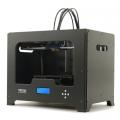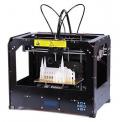Results 1 to 8 of 8
Thread: Rod flex under carriage weight
-
10-12-2015, 03:51 PM #1
Rod flex under carriage weight
So a downside of direct drive extruders is the added mass will cause the X-axis rods to flex. This is particularly apparent when the carriage is in the centre position as the carriage is now the furthest distance from a fixed support point. This can lead to tramming issues as the the nozzle-to-bed distance is smaller in the centre of the bed than the outside of the bed and people often mistakenly diagnose a warped bed to be the issue. In reality the cause is simple physics... the carriage is heavy and this added weight is causing the carriage to sag.
For interests sake I thought I'd run a little analysis to determine the amount of 'sag'. My printer has standard 8mm rods that are 400mm long. Many printers will fall in line with this. Total sag is 0.1mm in the centre position. In the analysis the drop distance is along the Y-axis, not the Z-axis.
First, the setup. Mesh and constraint/load placement:
01.JPG
Next the result. Deviation under load listed in the table:
02.JPG
Form the analysis its easy to see why many people, beginners in particular, struggling with levelling their beds and have adhesions issues with larger prints. If the desired 0.1mm gap is achieved in the bed centre this will create a 0.2mm gap on the outskirts of the bed... and suddenly prints don't adhere and start curling or coming loose. One solution is to go Bowden. Alternatively a gap compromise must be reached.
Hope this helps.

EDIT: the force exerted here is that of a standard FFCX dual extruder i.e 2 steppers with heater blocks, etc, heat spreader bar, carriage and 4 bearings. Total downward mass is approx. 720g or a downward force of 7.056N. This spread over 4 points representing the linear bearings.Last edited by Sebastian Finke; 10-13-2015 at 01:02 AM.
-
10-12-2015, 04:52 PM #2
??? The rods in our CTC are 8mm also but there is No flex or sag in them that I can see.
And I have put a lot pressure on them when cleaning extruders.
(at least 20 or 30 pounds of pressure)
The plastic parts at ends of rods would probably brake before rods bent.
I'm wondering if there is a difference in Wall-thickness of those tubes ?
thicker walls would certainly make them stronger.
Also if they are really Rods and not Tubes they would bend easier also.Last edited by EagleSeven; 10-12-2015 at 04:59 PM.
-
10-12-2015, 08:34 PM #3Student

- Join Date
- Sep 2015
- Location
- Liverpool
- Posts
- 25
I have 300mm 8mm rods, not sure of the exact weight of the carriage 3-400g, they are not supported both ends at the moment, the arm's more likely to want to bend at the point where it meets the Z.
How heavy is your carriage, what do the numbers say for sag with above dimensions?
-
10-13-2015, 01:12 AM #4
Trust me your rods will sag with force applied. 0.1mm is not discernible without using a gauge (either mechanical or light)
Why would you put your printer through that? Adding 15kg to the rods will ruin it.
They are solid rods.
-
10-13-2015, 01:12 AM #5
-
10-13-2015, 07:11 AM #6
Ah, they are Tubes in our printer,
Rods bend and flex much easier than Tubes do .
Regarding the excessive pressure : I got a Bad spool of filament once that kept braking-off inside the extruder
and I was using a brass-rod to push thur stuck filament chunks, after repeatedly removing nozzle
and I was other-wise having a Bad-day. I think you get the picture LOL
I did learn a valuable Lesson from that Bad spool, 'to check the filament flexibility Before using it'Last edited by EagleSeven; 10-13-2015 at 07:21 AM.
-
10-13-2015, 07:57 AM #7
This is why the drive mechanism and the weight bearing member should not be the same element unless the direction of drive is the direction of the load (Z), on equipment meant to handle that mass.
-
10-13-2015, 08:56 AM #8Student

- Join Date
- Sep 2015
- Location
- Liverpool
- Posts
- 25
I can't work it out from your edit but assume it's probaly half the flex in your rods, maybe even less due to the shorter rods. (but then I do have a little extra weight on the end of the rods/ preload) though they are probably more likely to bow than sag, or just tilt the arm, but the bed is level relative to the arm so it all looks ok at the moment.
Maybe if he arm/rods is tilting it doesnt bend?, and the tilt is compentated for in the bed, but no doubt it will try to tilt a little more as the head reaches the end of the arm, y backup plan if this happens is to add a counter balance, wires at the end of the arm up & over the Z-axis, so it looks more like a Crane, or just add the second Z-axis.Last edited by MechaBits; 10-13-2015 at 09:51 AM.





 Reply With Quote
Reply With Quote









Extruder not feeding during print,...
04-24-2024, 01:59 AM in Tips, Tricks and Tech Help